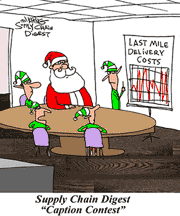Supply Chain Predictions 2023
Over the past thee weeks we looked back at 2022. I first wrote about what I thought were the biggest or most interesting supply chain stories by month. (See The Top Supply Chain Stories by Month 2022 and Top Supply Chain Stories by Month 2022 - Complete List.)
I next took a look at the performance of supply chain and logistics-related stocks in 2022 (See Supply Chain and Logistics Stocks Performance 2022. Last week, we offered our popular look at supply chain 2022 in numbers and charts.
| GILMORE SAYS: |
WHAT DO YOU SAY?'
Gartner recommends that companies analyze their need to assign work to the various robots and what orchestration logic will be needed to support this simultaneously.
Send us your
Feedback here
|
Now we start to look forward, with some supply chain predictions for 2023 and beyond. We start with some of what Gartner calls "predicts," more specificlly its predictions for supply chain technology. We summarize three of those five predicts below.
First up, Gartner analyst Amber Salley offers this prediction: By 2026, over 65% of supply chain planning decisions made in the short-term time horizon (zero weeks to less than three months) will be automated or autonomous.
I take it this means short-term supply chain planning is moving rapidly to be the work of machines, not people.
It seems it is less of a prediction and more of a reality. Salley notes a Gartner survey last year found that over half of short-term supply chain planning decisions are already automated or autonomous by leveraging data and analytics to support decision making.
There as a number of planning functions that have a majority of those decisions being automated or autonomous. That includes sales and operations execution (S&OE) (57%), order fulfillment/available to promise (56%), production planning (53%) and production scheduling (53%).
I am a little dubious that more than 50% of production scheduling isn't still massaged by human beings, but maybe I am behind the times.
Salley also notes that many newer vendors in the supply chain planning technology market are differentiating themselves by focusing on the short-term planning horizon, generally emphasizing advanced analytics and - what else - AI. But traditional vendors are certainly making similar pitches.
But Gartner says it is seeing a number of companies combining more traditional planning software with an AI/analytics platform supporting the short-term time horizon.
So what does it mean? Among other recommendations, Salley suggests that companies identify areas of greatest variability in the short-term time horizon. Next, they should determine which type of advanced analytic or AI techniques can be applied to better absorb the variability in planning, sometimes in combination.
Next up, my friend Dwight Klappich is back again with some predictions for robots in distribution and manufacturing, or what last year Garter tagged with the rather gangly name of "intralogistics robots," meaning those operating within the four walls of an operation.
In terms of predictions, Klappich says that by 2026, over 50% of companies deploying intralogistics robots will have a "multiagent orchestration platform."
What does that mean?
Klappich says multiagent (what it previously called multirobot) orchestration platforms act as intelligent middleware that integrates and orchestrates work between various business applications, heterogeneous fleets of operational robots, and other automated agents like doors or elevators.
Such a solution is needed, Klappich says, because "As companies expand their use of robotics, most will eventually have heterogeneous fleets of robots from different vendors performing various tasks. Integrating with and orchestrating the work of a varied fleet of robots will require standardized software that can easily integrate to a variety of agents and robot platforms."
These solutions will assign work to the right robots based on the characteristics of immediate tasks and will orchestrate communication between different robot platforms and other types of automation agents.
"As a company's fleet of robots grows, simple point-to-point API integration will not be enough," Klappich believes, adding that "Companies will need an orchestration capability that can assign work to the right robots based on near-real-time information and the characteristics of the activity."
He recommends that companies analyze their need to assign work to the various robots and what orchestration logic will be needed to support this simultaneously.
 Finally, Christian Titze and Tim Payne predict that through 2026, there will be no dominant area delivering a true DSCT, neither through broader business networks nor by planning apps or intelligent data lakes. Finally, Christian Titze and Tim Payne predict that through 2026, there will be no dominant area delivering a true DSCT, neither through broader business networks nor by planning apps or intelligent data lakes.
What is a DSCT? It is some type of control tower, I thought maybe a digital supply chain control tower, but the acronym is missing a C. Would have been nice to know.
Regardless, Gartner says companies further along in their digital supply chain journeys deploy a DSCT that "represents the reality of the physical end-to-end supply chain with all its correlations, attributes and uncertainties."
Does someone really have one of those?
Good to see Gartner say that "As of today, there is no real all-encompassing DSCT existing."
What does exist are just partial digital twins lacking either breadth and/or depth and typically covering only a few specific use cases. So if you don't have one, you aren't very far behind.
Gartner says the four main sources of emerging DSCT technology are:
1.Visibility/multienterprise supply chain business network providers such as e2open or One Network Enterprises.
2. Supply chain planning platforms such as Kinaxis and o9 Solutions.
3. Intelligent data platforms with vendors like bluecrux or Tada Cognitive Solutions utilizing a DSCT as an enabling factor embedded in their offering, which would be a more hybrid approach.
4. Internal development leveraging internal data science and IT resources.
However, "We do not see any predominant acceleration of any of the four options. It all depends on the individual company situation," Garter notes.
I am not quite sure what to make of all that. In terms of recommendations, Gartner first says that "More mature companies want to enable E2E visibility and support E2E decision making by being in lockstep with the real world supply chain."
Companies should "take an uncompromising position on reducing the number of decision-making models across the supply chain. A DSCT initiative implies ultimately a single model of the E2E supply chain."
Is that right? Think it will be a good while until companies get to that level.
Ok, think I will end it there. Back with more predictions next week.
What is your reaction to these Gartner predicts? Let us know your thought at the Feedback section below.
|





 Finally, Christian Titze and Tim Payne predict that through 2026, there will be no dominant area delivering a true DSCT, neither through broader business networks nor by planning apps or intelligent data lakes.
Finally, Christian Titze and Tim Payne predict that through 2026, there will be no dominant area delivering a true DSCT, neither through broader business networks nor by planning apps or intelligent data lakes.


